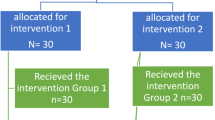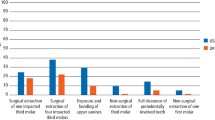Key Points
-
Highlights the significant morbidity experienced by patients admitted to hospital after paracetamol overdose secondary to dental pain.
-
Highlights the barriers experienced by patients in accessing timely dental care for acute dental pain.
-
Suggests the majority of paracetamol overdose cases secondary to dental pain could have been prevented and managed before analgesia overdose.
Abstract
Introduction There have been documented cases of serious and life-threatening health effects due to patients taking unintentional analgesia overdose secondary to dental pain. We aimed to determine firstly what proportion of unintentional paracetamol overdose cases admitted to an acute medical assessment unit (MAU) were secondary to dental pain, secondly what proportion of such cases encountered barriers to accessing emergency dental care and finally what clinical burden such cases placed on the hospital services.
Method The clinical coding department provided information to allow appropriate identification and data collection from patient discharge summaries and case notes of all unintentional paracetamol overdose cases secondary to dental pain over a 24 month period (1 March 2012 to 28 February 2014).
Results One hundred and sixteen admissions were identified specifically for unintentional paracetamol overdose. Dental pain accounted for 48 (41%) of all cases. Females (67%) were twice as likely to be admitted, compared to males (33%), with a mean age of 36 years and four months. Thirty-two (63%) non-dentally registered and all nine (100%) registered patients were unable to access timely emergency dental care before their admission. Forty cases (83%) were referred to the hospital oral and maxillofacial services (OMFS). Thirty-seven (93%) patients underwent elective outpatient dental extractions and the remaining three (7%) patients were admitted for intravenous antibiotics, incision and drainage and dental extractions. All patients were treated under local anaesthetic.
Conclusion Dental pain is the single most common cause of acute medical admission secondary to unintentional paracetamol overdose. Patients registered with a general dental practitioner (GDP), as well as those not registered with a GDP, had difficulty accessing timely emergency primary dental care.
Similar content being viewed by others
Log in or create a free account to read this content
Gain free access to this article, as well as selected content from this journal and more on nature.com
or
References
Thomas M B, Moran N, Smart K, Crean S . Paracetamol overdose as a result of dental pain requiring medical treatment – two case reports. Br Dent J 2007; 203: 25–28.
Dodd M D, Graham C A . Unintentional overdose of analgesia secondary to acute dental pain. Br Dent J 2002; 193: 211–212.
Vogel J, Heard K J, Carlson C, Lange C, Mitchell G . Dental pain as a risk factor for accidental acetaminophen overdose: a case-control study. Am J Emerg Med 2011; 29: 1125–1129.
Heard K J, Ries N L, Dart R C, Bogdan G M, Zallen R D, Daly F . Overuse of non-prescription analgesics by dental clinic patients. BMC Oral Health 2008; 8: 33.
Preshaw P M, Meechan J G, Dodd M D . Self-medication for the control of dental pain: what are our patients taking? Dent Update 1994; 304: 299–301.
Fosnocht D, Taylor J R, Caravati E M . Emergency department patient knowledge concerning acetaminophen (paracetamol) in over-the-counter and prescription analgesics. Emerg Med J 2008; 25: 213–216.
Hornsby L B, Whitley H P, Hester E K, Thompson M, Donaldson A . Survey of patient knowledge related to acetaminophen recognition, dosing and toxicity. J Am Pharm Assoc 2010; 50: 485–489.
Stumpf J L, Skyles A J, Alaniz C, Erickson S R . Knowledge of appropriate acetaminophen doses and potential toxicities in an adult clinic population. J Am Pharm Assoc 2007; 47: 35–41.
Cham E, Hall L, Ernst A A, Weiss S J . Awareness and use of over-the-counter pain medications: a survey of emergency department patients. South Med J 2002; 95: 529–535.
Sullivan I O, Lader D, Seymour C B, Chenery V, Fuller E, Sadler K . Foundation Report: Adult Dental Health Survey 2009. The Health and Social Care Information Centre, Leeds, 2011.
Sheffield Teaching Hospital NHS Foundation Trust. Accident & Emergency. 2015. Online information available at: http://www.sth.nhs.uk/services/a-z-of-services?id=3 (accessed May 2015).
Ferner R E, Dear J W, Bateman D N . Management of paracetamol poisoning. BMJ. 2011; 342: 10.1136/bmj.d2218. Available at: http://www.bmj.com/content/342/bmj.d2218.long (accessed September 2015).
Medicines and Healthcare products Regulatory Agency. Paracetamol overdose: new guidance on treatment with intravenous acetylcysteine. MHRA, 2012.
Medicines and Healthcare products Regulatory Agency. Paracetamol overdose- revised single line treatment nomogram. MRHA, 2012.
Medicines and Healthcare products Regulatory Agency. Acetylcysteine 200 mg/ml injection for infusion. MRHA, 2012.
Nayyer N V, Byers J, Marney C . Identifying adults at risk of paracetamol toxicity in the acute dental setting: development of a clinical algorithm. Br Dent J 2014; 216: 229–235.
Author information
Authors and Affiliations
Corresponding author
Additional information
Refereed Paper
Rights and permissions
About this article
Cite this article
Siddique, I., Mahmood, H. & Mohammed-Ali, R. Paracetamol overdose secondary to dental pain: a case series. Br Dent J 219, E6 (2015). https://doi.org/10.1038/sj.bdj.2015.706
Accepted:
Published:
Issue date:
DOI: https://doi.org/10.1038/sj.bdj.2015.706
This article is cited by
-
Urgent dental care use in the North East and Cumbria: predicting repeat attendance
British Dental Journal (2022)
-
Racial variations in tooth pain and care-seeking in adolescents in Malaysia
BDJ Open (2021)
-
Analgesie in der zahnärztlichen Praxis
wissen kompakt (2021)
-
Safe use of paracetamol and high-dose NSAID analgesia in dentistry during the COVID-19 pandemic
British Dental Journal (2020)
-
Assessment of public and professional perceptions of access to unscheduled dental care
British Dental Journal (2018)



